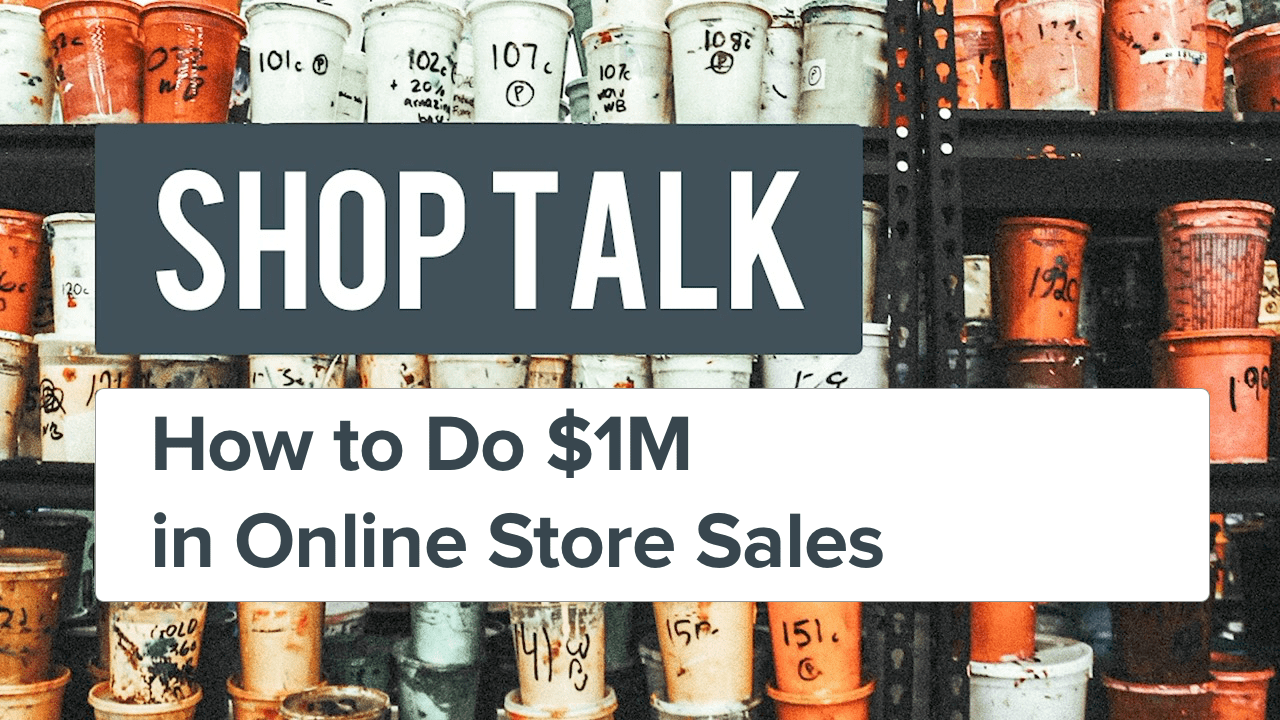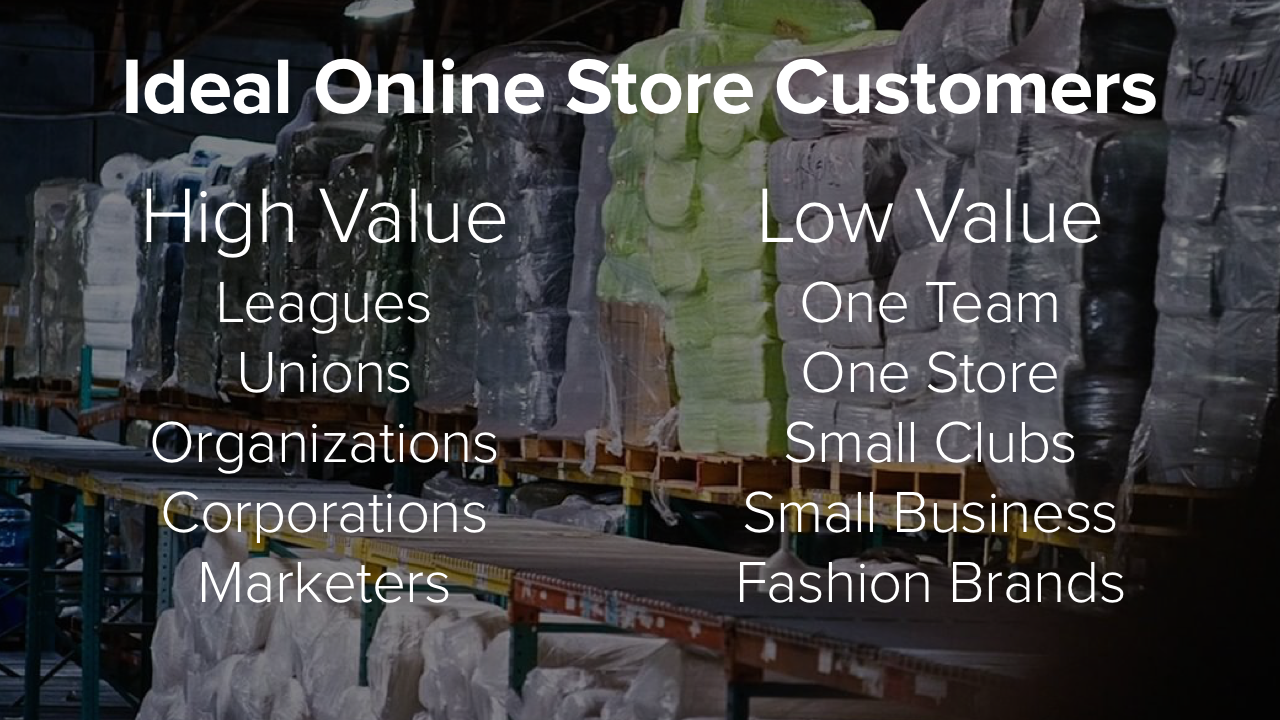Steven Farag from Campus Ink was the first user of Printavo Merch [Beta].
Why?
Without Steven’s input and willingness to test Printavo Merch, it would never have happened.
Steven didn’t start out with a squeegee in his hand. He started out in the screen printing and custom merchandise industry by building online stores. He’s well-versed in building customer profiles, creating clear rules and guidelines for successful online stores, and handling the complications that online stores introduce.
Printavo founder Bruce Ackerman sat down with Steven to discuss the best practices and procedures for starting off with online stores.
Treat Printavo Merch stores like a luxury service
Always upcharge for custom online stores. Steven suggests a 10% upcharge for the convenience you’re providing.
Think about it: you’re really simplifying things for your customers by providing this service. They don’t have to:
- Take orders, sizes, and customizations
- Manage distribution
- Do quantity and quality checks
- Deal with handling cash and payment
That’s a lot of added value for parents, coaches, marketing professionals, and organizational leaders.
Steven utilizes a different pricing matrix for Printavo Merch customers. The upcharge is built straight in to the cost of the garments and merchandise.
Set clear guidelines for your customers
Some stores will go totally gangbusters and blow away your wildest expectations. Other stores will fall flat on their face. You want to focus on the most successful and quickly stop the underperformers.
It’s imperative to set clear guidelines and rules about how you’ll handle stores. Your best bet is to create a set of transparent policies around how you’ll manage your Printavo Merch online stores. Here’s what Steven has had success with:
- Always have a specific store minimum that’s required before you’ll print the order. If the store doesn’t hit its target sales amount (whether that’s a dollar amount or a number of garments sold) you shouldn’t fulfill the orders. Be firm about this.
- Never extend store deadlines. Do not fall into the trap of extending stores. This will disrupt your production and fulfillment workflow. If a store fails to meet its minimums, close it!
- Clearly lay out expected delivery times. Start the process of scheduling jobs based on the dates that stores close. Explain that you’ll fulfill orders after the store closes and communicate about production and delivery times. 7 to 14 days is not unreasonable – remember, you’re not Amazon!
- Create a clear document outlining your policies. A simple, point-by-point document that covers the ins and outs of your online store policies goes a long way.
Steven suggests a minimum of around 24 pieces. He also simplifies his printing and fulfillment process by allowing 3 garment styles, but only one logo across the different styles.
Build the right customer profile for Merch stores
“The worst thing that can happen is that you sell fewer items with a Merch store than you would with a simple bulk order.”
Online stores are great for your business because they provide a steady stream of income. But if you do them poorly – or provide them for the wrong customers – they can absolutely wind up making less money than traditional bulk custom orders. Just because a store is exists doesn’t mean that people will use it.
You want to target organizations that have:
- Genuine need for custom merchandise
- Lots of connections and people that would want their merch
- Sustained presence in their community or niche
For example: you’d want to target a motorcyclist enthusiast group over a motorcycle dealership. You’d probably have more success with a festival instead of a band. You’re much more likely to find that leagues can sustain online stores far better than individual teams. Consider how many people the organization touches and how enthusiastic those people would be about “wearing the brand.”
The key here is thinking big. Find businesses and organizations that don’t do distribution – either because of time constraints, business constraints, or simply being spread out too far apart.
Bag-and-tag is a must
Bag-and-tag is the simplest and easiest way to add value to online store orders. Why? Imagine this scenario:
You send a busy parent their order of 100 baseball uniforms for their Little League tournament. You’ve done your usual QA process, counted everything three times, and have ensured the entirety of the order was shipped. A few hours after you see that the package was delivered, the parent calls and tells you that there’s 3 or 4 small uniforms missing. They can’t go to the tournament without their uniforms! You agree to reprint the (supposedly) missing shirts.
You spend two hours burning and setting up screens, printing the order, and then – to go above and beyond – you rush ship it out. It costs you quite a bit of time and money, but you really want this customer to come back next year.
A couple of days later, you email the customer and proudly explain how happy you were to fulfill their order – and apologize for the error. They write back, “Thanks for the help. But I just miscounted the uniforms and didn’t see that they were there! Do you want us to send the uniforms you printed back to us?”
This is why bag-and-tag is so important: you control the packaging and outcome and know it’s correct before it gets to the customer.
There’s another layer of value that you add when you control bagging and tagging. You can create a strong branded experience based around your shop. Steven inserts a pamphlet about Custom Ink, utilizes high quality plastic bags with his shop’s logo on them, and even splurges on nicer branded boxes for shipping. This boosts the customer’s perception of your shop and encourages anyone purchasing from the store to find out about your brand.
Don’t dive in head first
As exciting as it might be to start offering online stores with hundreds of products and a huge variance in logos and designs, Steven suggests starting small so you can work out the kinks in your workflow.
Once you’ve figured out who your ideal online store candidates are, try working with them on a small promotion to start. Offer a handful of garments, and a single simple design. See how the store does and learn from what happens so you can adjust your strategy.
Once you’ve integrated Printavo Merch online stores into your production workflow, you can begin increasing the complexity of the offerings from your stores. It really is just another service you can offer to customers – so don’t lose sight of that fact. Ground your decisions in what’s best for your shop’s existing workflow!
Be ready to experiment with pricing
Steven doesn’t have all of the answers about pricing. But he suggests starting around +/- $2 of the garment manufacturer’s suggested retail price. He also suggests working with the customer to set the prices.
Some customers will want to go as low as they can. Others will want to make money hand-over-fist. As the expert, you should guide the customer toward a decision that’s profitable for them and for you.
Conclusion and summary
- Merch is a luxury service. Treat it – and price it – accordingly. An upcharge is easy to justify.
- Create a document with requirements and expectations for customers. Clear communication can save you a lot of work. Stop the questions before they begin.
- Target the right brands and organizations. Bigger and more beloved is better than smaller and less connected. “Does their grandma want one, too? That’s a brand to target.”
- Add value and reduce headaches with bag-and-tag service. Your customers are busy enough. Make their lives easier – and, in the long term, yours – by tacking bag-and-tag service on.
- Start small. You’ll have to adapt your workflow to handle your new service. Don’t blow up your shop by biting off more than you can chew.
- Work on prices in tandem with customers. Some will want to make a lot. Others will want to get their merch out cheaply. Price accordingly, but make sure you’re still making money.
Work on Printavo Merch [Beta] continues! We are slowly rolling out this new and exciting way to simplify online stores to around 50 shops a day. If you’d like to get in on our invitation-only beta testing period, be sure to sign up. We’re dedicated to bringing you the simplest and easiest way to create streamlined online stores for your screen printing, embroidery, custom apparel, and branded merchandise customers.
We will continue to provide you with actionable resources to make the most of our new product. Keep pushing!




0 Comments